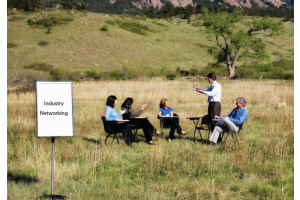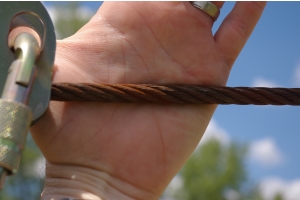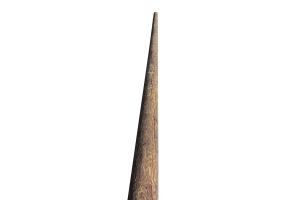keith jacobs
-
November 21, 2018
A pulley is a simple machine that uses a rope and a grooved wheel to lift heavy objects. Pulleys are used in a variety of applications, including cranes, hoists, and elevators, but are also common pieces of hardware and equipment used on challeng coursses, aerial adventure parks and ziplines for rigging, element construction and emergancy rescue.
The parts of a pulley are:
- Grooved wheel: The grooved wheel is the heart of the pulley. It is the part that the rope is wrapped around.
- Axle: The axle is the central shaft of the pulley. It is what the wheel rotates on.
- Bearings: The bearings support the axle and allow it to rotate freely.
- Rope: The rope is what is used to lift the object. It is wrapped around the grooved wheel.
- Sheave: The sheave is the name for the grooved wheel.
When choosing a pulley, there are -
October 11, 2018
Installing a nut eye bolt and/or thimble eye bolt with washers into a utility pole or tree for a challenge course or ropes course element is a relatively simple process, but it is important to follow the correct steps to ensure the safety of your participants.
Materials Needed
- Nut eye bolt or Thimble eye bolt (optional)
- Washers (round, square or curved square and double coil locking washer)
- Drill
- Level
- Drill Bit /Auger Bit - 1/8" to 1/2" larger in diameter than bolt size (ex. if 5/8" bolt then 11/16 or 3/4" drill bit)
- Tape measure (to ensure even height on each side)
- Safety glasses
- Gloves
Instructions
Choose a location for the nut eye bolt or thimble eye bolt that is high enough to be out of reach of participants, but low enough to be easily accessible for maintenance.
- Use a level to make sure that the location is level (very important for installation of
-
December 14, 2017
Carabiners are essential pieces of equipment for a variety of activities, including rock climbing, mountaineering, and industrial work. They are used to connect ropes, chains, and other equipment together, and they must be strong and reliable.
When choosing a carabiner, it is important to consider the following factors:
- The type of activity you will be using it for. Different activities require different types of carabiners. For example, rock climbers need carabiners that are lightweight and easy to clip, while industrial workers need carabiners that are strong and durable.
The load the carabiner will need to support. Carabiners are rated for different loads, so it is important to choose one that is rated for the weight of the load you will be hanging from it.
The locking mechanism. Carabiners come with a variety of locking mechanisms, including screw gates, auto-locking gates, and magnetic
-
October 27, 2016
Rock climbing helmets are an essential piece of safety equipment for any climber. They protect your head from injury in the event of a fall, and they can also help to keep you warm and comfortable in cold weather. There are many different types of rock climbing helmets on the market, so it's important to choose one that's right for you.
Here are some factors to consider when choosing a rock climbing helmet:
- Fit: The most important factor to consider when choosing a rock climbing helmet is fit. The helmet should fit snugly but comfortably on your head, and it should not move around when you move your head. You should also be able to adjust the straps to get a good fit.
- Weight: Rock climbing helmets can vary in weight, so it's important to choose one that's comfortable to wear for long periods of time.
- Ventilation: Rock climbing helmets can get hot, so it's important to choose one with good ventilation.
-
March 07, 2016
When it comes to ropes, there are two main types: dynamic and static. Dynamic ropes are designed to stretch, while static ropes are not. This difference in elasticity is what makes dynamic ropes ideal for climbing and challenge courses, while static ropes are better suited for other applications, such as rigging and securing loads.
Dynamic Ropes
Dynamic ropes are made from a variety of materials, including nylon, polyester, and Dyneema. They are designed to stretch when a load is applied, such as when a climber falls. This stretching absorbs the force of the fall, which helps to protect the climber from injury. Dynamic ropes are also more abrasion-resistant than static ropes, which makes them ideal for climbing on rough surfaces.
Static Ropes
Static ropes are not designed to stretch. They are made from materials that are strong and durable, such as nylon and polyester. Static ropes are ideal for applications where
-
February 27, 2016
Auto belay devices are a new safety innovation that is quickly becoming the standard for challenge courses and ropes courses. Auto belay devices use a variety of sensors to monitor the user's safety and automatically shut off the belay system if there is a fall. This provides an added layer of safety for participants, and it can help to reduce the risk of serious injuries.
History of Auto Belay Devices
The first auto belay devices were developed in the early 2000s. These early devices were bulky and expensive, and they were not widely adopted by the challenge course and ropes course industry. However, in recent years, there has been a significant improvement in the technology and design of auto belay devices. As a result, they are now more affordable, more compact, and easier to use. As a result, they are now being adopted by more and more challenge courses and ropes courses.
How Auto Belay Devices Work
Auto belay
-
May 03, 2015
Working at height is a common occurrence in the ropes course industry. Employees may be required to climb towers, traverse high ropes courses, or work on elevated platforms. As a result, it is important for employers to take steps to ensure the safety of their employees.
One of the most important things that employers can do is to ensure that their employees are properly trained in fall protection. Employees should be trained on how to use fall protection equipment, such as harnesses, lanyards, and lifelines. They should also be trained on how to recognize and avoid fall hazards.
Employers should also provide their employees with the proper personal protective equipment (PPE). This includes hard hats, safety glasses, gloves, and steel-toed boots. Employees should be required to wear this PPE at all times when working at height.
In addition to training and PPE, employers should also implement a fall protection plan. This plan should identify the fall hazards at the worksite
-
February 17, 2014
Guy anchors are an important safety feature for challenge courses and zip lines. They are used to secure the cables that support the courses and lines, and they must be strong enough to withstand








